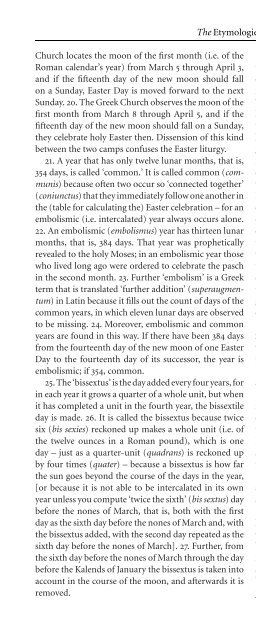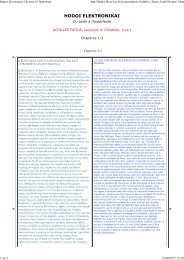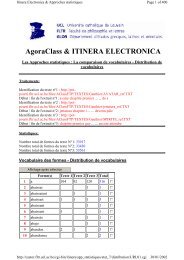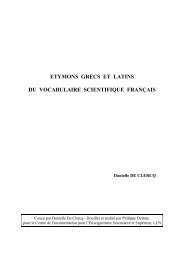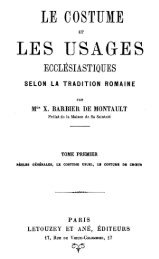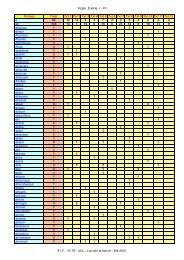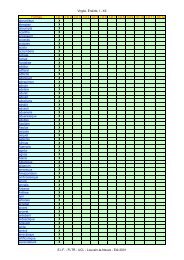The Etymologies of Isidore of Seville - Pot-pourri
The Etymologies of Isidore of Seville - Pot-pourri
The Etymologies of Isidore of Seville - Pot-pourri
You also want an ePaper? Increase the reach of your titles
YUMPU automatically turns print PDFs into web optimized ePapers that Google loves.
Church locates the moon <strong>of</strong> the first month (i.e. <strong>of</strong> the<br />
Roman calendar’s year) from March 5 through April 3,<br />
and if the fifteenth day <strong>of</strong> the new moon should fall<br />
on a Sunday, Easter Day is moved forward to the next<br />
Sunday. 20.<strong>The</strong>GreekChurchobserves the moon <strong>of</strong> the<br />
first month from March 8 through April 5, andifthe<br />
fifteenth day <strong>of</strong> the new moon should fall on a Sunday,<br />
they celebrate holy Easter then. Dissension <strong>of</strong> this kind<br />
between the two camps confuses the Easter liturgy.<br />
21. Ayear that has only twelve lunar months, that is,<br />
354 days, is called ‘common.’ It is called common (communis)because<br />
<strong>of</strong>ten two occur so ‘connected together’<br />
(coniunctus)that they immediately follow one another in<br />
the (table for calculating the) Easter celebration – for an<br />
embolismic (i.e. intercalated) year always occurs alone.<br />
22.Anembolismic (embolismus)year has thirteen lunar<br />
months, that is, 384 days. That year was prophetically<br />
revealed to the holy Moses; in an embolismic year those<br />
who lived long ago were ordered to celebrate the pasch<br />
in the second month. 23. Further ‘embolism’ is a Greek<br />
term that is translated ‘further addition’ (superaugmentum)inLatin<br />
because it fills out the count <strong>of</strong> days <strong>of</strong> the<br />
common years, in which eleven lunar days are observed<br />
to be missing. 24. Moreover, embolismic and common<br />
years are found in this way. If there have been 384 days<br />
from the fourteenth day <strong>of</strong> the new moon <strong>of</strong> one Easter<br />
Day to the fourteenth day <strong>of</strong> its successor, the year is<br />
embolismic; if 354, common.<br />
25.<strong>The</strong>‘bissextus’ is the day added every four years, for<br />
in each year it grows a quarter <strong>of</strong> a whole unit, but when<br />
it has completed a unit in the fourth year, the bissextile<br />
day is made. 26. Itiscalled the bissextus because twice<br />
six (bis sexies) reckoned up makes a whole unit (i.e. <strong>of</strong><br />
the twelve ounces in a Roman pound), which is one<br />
day – just as a quarter-unit (quadrans) isreckonedup<br />
by four times (quater) –because a bissextus is how far<br />
the sun goes beyond the course <strong>of</strong> the days in the year,<br />
[or because it is not able to be intercalated in its own<br />
year unless you compute ‘twice the sixth’ (bis sextus)day<br />
before the nones <strong>of</strong> March, that is, both with the first<br />
day as the sixth day before the nones <strong>of</strong> March and, with<br />
the bissextus added, with the second day repeated as the<br />
sixth day before the nones <strong>of</strong> March]. 27. Further, from<br />
the sixth day before the nones <strong>of</strong> March through the day<br />
before the Kalends <strong>of</strong> January the bissextus is taken into<br />
account in the course <strong>of</strong> the moon, and afterwards it is<br />
removed.<br />
<strong>The</strong> <strong>Etymologies</strong> VI.xvii.20–xviii.5 145<br />
28.Intercalary (intercalaris)daysare so called because<br />
they are interposed (interponere) sothatthereckoning<br />
<strong>of</strong> the sun and the moon may be reconciled, for calare<br />
means “pose,” and intercalare means “interpose.” 29.<br />
What Greeks call ‘epacts’ (epacta) the Latins call ‘annual<br />
lunar additions,’ which run through a cycle from eleven<br />
to thirty days. <strong>The</strong> Egyptians add epacts to make the<br />
lunar measurement equal to the reckoning <strong>of</strong> the sun.<br />
30.Forthe moon in its course is known to shine twentynine<br />
and a half days, so that there are 354 (i.e. 12 × 29.5)<br />
days in a lunar year; there remain in the course <strong>of</strong> a solar<br />
year eleven days, which the Egyptians add (adicere). 31.<br />
Hence they are called additions (adiectio). Without these<br />
epacts you would not find what point <strong>of</strong> the lunar cycle<br />
corresponds to a given year and month and day. Those<br />
epacts are always added on March 21,onthe same day <strong>of</strong><br />
the moon that falls on that date. 32. <strong>The</strong>reare nineteen<br />
years in the (Metonic) cycle, but when the epacts add<br />
up to twenty-nine, which is in the nineteenth year <strong>of</strong> the<br />
cycle, at that point you do not add eleven epacts to the<br />
twenty-nine in the following year, such that you would<br />
get ten after subtracting thirty, but you start again with<br />
eleven.<br />
xviii. <strong>The</strong> other liturgical feasts (De reliquis festivitatibus)<br />
1. A‘festal celebration’ (festivitas) issocalled<br />
from ‘festal days’ (festus dies), as if the word were festiditas,<br />
because during those days only sacred activities<br />
are carried out. <strong>The</strong> contrary to these are court-days<br />
(fasti), on which the law ‘speaks’ (fari, ppl. fatus), that<br />
is, is pronounced. A ‘solemn feast’ (sollemnitas) isso<br />
called from its holy rites, a day adopted in such a way<br />
that for religious reasons it ought not to be changed.<br />
It is named from ‘customary’ (solitus), that is, firm and<br />
solid (solidus), [or because it is customarily (solere)performed<br />
in the church year]. 2. Acelebration (celebritas)<br />
moreover is so called because during it earthly<br />
activity is not carried out, but only celestial (caelestis)<br />
activities.<br />
3.EasterDayisthefirst <strong>of</strong> all the feasts; we have spoken<br />
<strong>of</strong> thistermabove.4. LikeEasterDay, Pentecost<br />
was a feast day among the Hebrews, because it was celebrated<br />
five tens <strong>of</strong> days after Easter Day – whence it takes<br />
its name, for means “five” in Greek. On that day<br />
according to the Law the ‘loaves <strong>of</strong> proposition’ would<br />
be <strong>of</strong>fered from the new crops (Exodus 25:30,etc.). 5.<strong>The</strong><br />
jubilee year in the Old Testament adumbrated this, and


